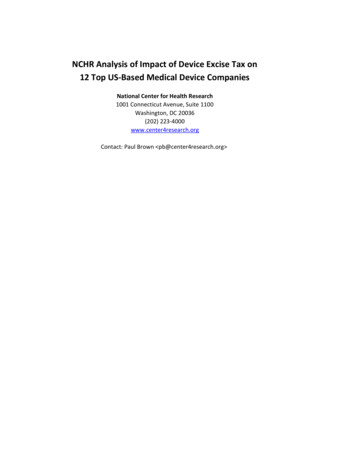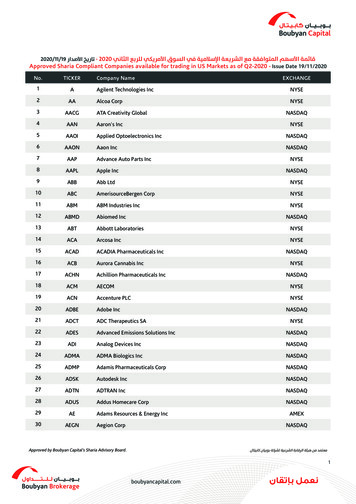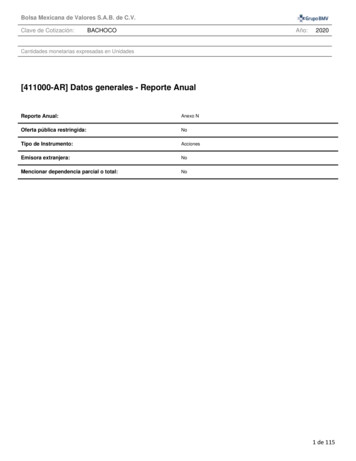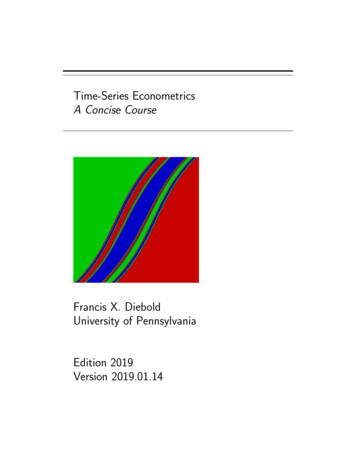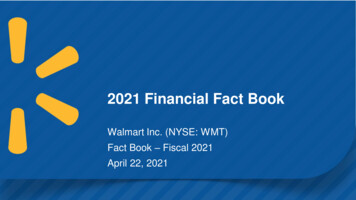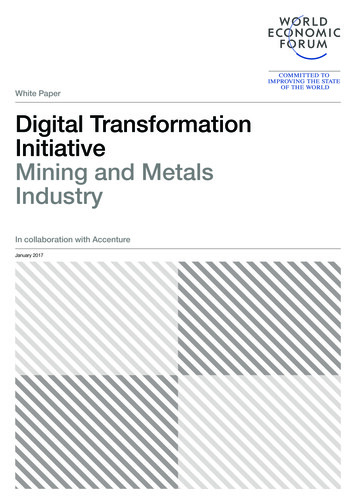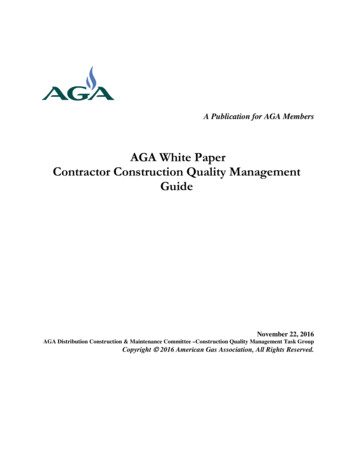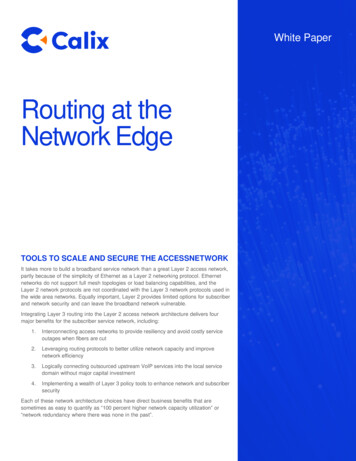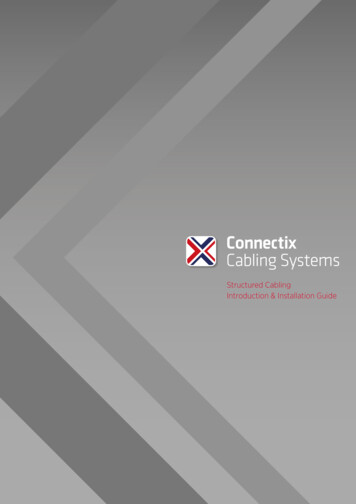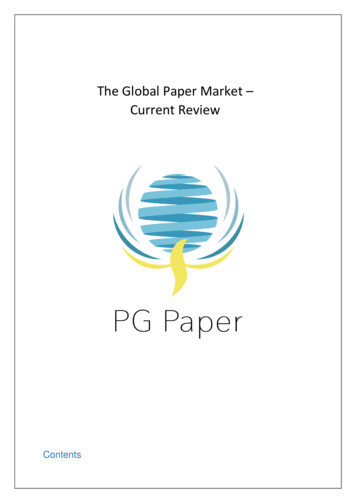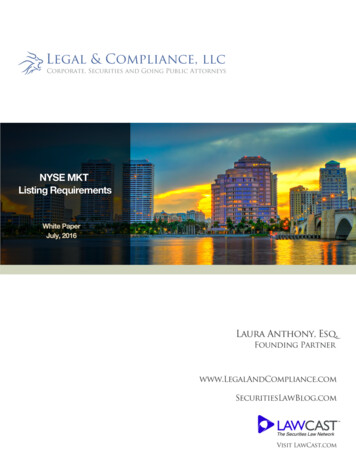
Transcription
July, 2016NYSE MKT Listing RequirementsThis blog is the second in a two-part series explaining the listing requirements for the two small-cap national exchanges,NASDAQ and the NYSE MKT.General Information and Background on NYSE MKTThe NYSE MKT is the small- and micro-cap exchange level of the NYSE suite of marketplaces. The NYSE MKT wasformerly the separate American Stock Exchange (AMEX). In 2008, the NYSE Euronext purchased the AMEX and in2009 renamed the exchange the NYSE Amex Equities. In 2012 the exchange was renamed to the current NYSE MKTLLC. The NASDAQ and NYSE MKT are ultimately business operations vying for attention and competing to attract thebest publicly traded companies and investor following. The NYSE MKT homepage touts the benefits of choosing thisexchange over others, including “access to dedicated funding, advocacy, content and networking and the industry’s firstsmall-cap services package.”Although there are substantial similarities among the different exchanges, and each is governed by the same overallSEC rules and regulations, each exchange also has its own unique differences. Moreover, each exchange has its ownsets of rules and regulations that listing companies must comply with in order to obtain and maintain its listingqualification.Like all exchanges, and the OTCQX tier of the OTC Markets, the NYSE MKT offers investor relations, broker-dealernetworking and marketing services to its listed companies. The NYSE MKT’s distinctive formula is the DesignatedMarket Maker (DMM) model (formerly referred to as a Specialist). A DMM is assigned to each security and uses bothmanual and electronic metrics and algorithms to help stabilize market price and trading volume.NASDAQ does not have internal DMM’s (or Specialists), but rather relies on market makers in general to increasevolume and liquidity in NASDAQ traded securities and hopefully decrease volatility. Whereas the NYSE MKT relies onboth manual (human) and electronic trading oversight, the NASDAQ is purely electronic. The NYSE MKT has an auctionmodel run by the DMM’s. The DMM reports all bids and asks into the marketplace, quoting the National Best Bid andOffer (NBBO) a required minimum percentage of time, and sets the opening price of its assigned securities eachday. The opening price may be different than the prior day’s closing price due to after-market trading or any other factorthat affects supply and demand.In other words, the DMM is an intermediary between the broker/dealer/market participants and the execution of tradesthemselves. It is thought that using a DMM will increase trading liquidity and volume, because the DMM is motivated tomatch buyers and sellers and fulfill trading requests by either using its own inventory of the security or finding brokerdealers with matching orders. A DMM may even solicit a broker-dealer to act as the counterparty to a requested trade.NASDAQ does not have the auction or DMM model. Rather, NASDAQ relies on market makers. Market makers mustquote both a firm bid price and firm ask price they are willing to honor. Each NASDAQ security has multiple marketmakers (generally at least 14) competing for trades, and helping to ensure that the bid-ask spread is low and that supplyand demand results in the best execution prices.2
Initial and Continuing Listing StandardsA company seeking to list securities on NYSE MKT must meet minimum listing requirements, including specifiedfinancial, liquidity and corporate governance criteria. NYSE MKT has broad discretion over the listing process and maydeny an application, even if the technical requirements are met, if it believes such denial is necessary to protect investorsand the public interest. Factors the NYSE MKT consider include, but are not limited to, the nature of a company’sbusiness; the market for its products; its regulatory history; its past corporate governance activities; the reputation of itsmanagement; its historical record and pattern of growth; its financial integrity (including filing for bankruptcy); itsdemonstrated earning power and its future outlook.Once listed, a company must meet continued listing standards. In order to apply for listing on NYSE MKT, a companymust complete and submit a listing application including specified documents and information. The quantitative andqualitative standards for initial listing of U.S. companies on NYSE MKT (the “Exchange”) are summarized below.NYSE MKTListing StandardsCriteriaStandard 1Standard 2Standard 3Standard 4 750,00N/AN/AN/AMarketcapitalizationN/AN/A 50 million 75 million or at least 75million in total assets and(1) 75 million in revenuesMarket value of(2)public float 3 million 15 million 15 million 20 millionMinimum Price 3 3 2 3Operating HistoryN/A2 yearsN/AN/AShareholders’Equity 4 million 4 million 4 millionN/APublicshareholders/Public(2)float (shares)Option 1: 800/500,000Option 2: 400/1,000,000(3)Option 3: 400/500,000Pre-tax Income(1)(1) Required in the latest fiscal year, or two of the three most recent fiscal years.(2) Public shareholders and public float do not include shareholders or shares held directly or indirectly by any officer,director, controlling shareholder or other concentrated (i.e., 10 percent or greater), affiliated or family holdings.3
(3) Option 3 requires a daily trading volume of at least 2,000 shares during the six months prior to listing.NYSE MKT Listing FeesNumber of SharesOriginal Listing (Initial)Continued Listing (Annual)Up to 5 million 50,000 30,000 (minimum)5 to 10 million 55,000 30,00010 to 15 million 60,000 30,00015 to 25 million 75,000 30,00025 to 50 million 75,000 30,00050 to 75 million 75,000 40,000More than 75 million 75,000 45,000 (maximum)Corporate Governance StandardsThe NYSE MKT requires listed companies to adhere to its corporate governance standards, nDistribution ofAnnual or InterimReportsThe company must make its annual and interim reports available toshareholders, either by mail or electronically through the company’s website.IndependentDirectorsThe Exchange has various requirements regarding a company’s independentdirectors and audit committee. Although generally he company’s board ofdirectors is required to have a majority of independent directors, there areseveral exceptions, such as for a controlled company or smaller reportingcompany.Audit CommitteeThe company is required to have an audit committee consisting solely ofindependent directors who also satisfy the requirements of SEC Rule 10A-3 andwho can read and understand fundamental financial statements. The auditcommittee must have at least three members. One member of the audit4
committee must have experience that results in the individual’s financialsophistication.Compensation ofExecutive OfficersThe company is required to have a compensation committee consisting solely ofindependent directors and having at least two members. In addition, Rule5605(d)(2)(A) includes an additional independence test for compensationcommittee members. The compensation committee must determine, orrecommend to the full board for determination, the compensation of the chiefexecutive officer and all other executive officers.Nomination ofDirectorsIndependent directors must select or recommend nominees for directors.Code of ConductThe company must adopt a code of conduct applicable to all directors, officersand employees.Annual MeetingsThe company is required to hold an annual meeting of shareholders no laterthan one year after the end of its fiscal year.SolicitationProxiesThe company is required to solicit proxies for all shareholder meetings.ofQuorumThe company must provide for a quorum of not less than 33 1/3% of theoutstanding shares of its voting stock for any meeting of the holders of itscommon stock.Conflict of InterestThe Exchange requires a listed company to utilize its audit committee toconduct an appropriate review of all related party transactions on an ongoingbasis.ShareholderApprovalThe company is required to obtain shareholder approval of certain issuances ofsecurities, including:5 Acquisitions where the issuance equals 20% or more of the pretransaction outstanding shares, or 5% or more of the pre-transactionoutstanding shares when a related party has a 5% or greater interest inthe acquisition target Issuances resulting in a change of control Equity compensation Private placements where the issuance equals 20% or more of the pretransaction outstanding shares at a price less than the greater of bookor market value
Voting RightsCorporate actions or issuances cannot disparately reduce or restrict the votingrights of existing shareholders.The Seasoning RulesThe seasoning rules, which were adopted in late 2011, prohibit a company that has completed a reverse merger with apublic shell from applying to list until the combined entity had traded in the U.S. over-the-counter market, on anothernational securities exchange, or on a regulated foreign exchange, for at least one year following the filing of all requiredinformation about the reverse merger transaction, including audited financial statements. In addition, the rules requirethat the new reverse merger company has filed all of its required reports for the one-year period, including at least oneannual report.In addition, the seasoning rule requires that the reverse merger company “maintain a closing stock price equal to thestock price requirement applicable to the initial listing standard under which the reverse merger company is qualifying tolist for a sustained period of time, but in no event for less than 30 of the most recent 60 trading days prior to the filing ofthe initial listing application.”The rule includes an exception for companies that complete a firm commitment offering resulting in net proceeds of atleast 40 million.In addition to the specific additional listing requirements contained in the new rule, the Exchange may “in its discretionimpose more stringent requirements than those set forth above if the Exchange believes it is warranted in the case of aparticular reverse merger company based on, among other things, an inactive trading market in the reverse mergercompany’s securities, the existence of a low number of publicly held shares that are not subject to transfer restrictions, ifthe reverse merger company has not had a Securities Act registration statement or other filing subjected to acomprehensive review by the SEC, or if the reverse merger company has disclosed that it has material weaknesses in itsinternal controls which have been identified by management and/or the reverse merger company’s independent auditorand has not yet implemented an appropriate corrective action plan.”Benefits of Trading on the NYSE MKTThere are many benefits to trading on an exchange as opposed to the OTC Markets. The biggest benefits to anexchange are the ability to attract analyst coverage and institutional investors, and the corresponding increase in liquiditythat comes with both. Stocks that trade on the NYSE MKT tend to have a lower bid-offer spread—again, encouragingtrading volume and liquidity. Exchange traded securities are exempt from the penny stock definition, allowing for moremarket maker and broker-dealer participation. As further explained in my blog on the NASDAQ Listing Requirements, abroker-dealer cannot recommend a penny stock transaction to its retail clients, and therefore, no analysts, financialadvisors, or institutional investors make recommendations for purchases of penny stocks.6
The AuthorAttorney: Laura Anthony, Esq.,Founding Partner, Legal & Compliance, LLCSecurities attorney Laura Anthony and her experienced legal team provides ongoing corporate counsel to small and midsize private companies, OTC and exchange traded issuers as well as private companies going public on the NASDAQ,NYSE MKT or over-the-counter market, such as the OTCQB and OTCQX. For nearly two decades Legal & Compliance,LLC has served clients providing fast, personalized, cutting-edge legal service. The firm’s reputation and relationshipsprovide invaluable resources to clients including introductions to investment bankers, broker dealers, institutionalinvestors and other strategic alliances. The firm’s focus includes, but is not limited to, compliance with the Securities Actof 1933 offer sale and registration requirements, including private placement transactions under Regulation D andRegulation S and PIPE Transactions as well as registration statements on Forms S-1, S-8 and S-4; compliance with thereporting requirements of the Securities Exchange Act of 1934, including registration on Form 10, reporting on Forms 10Q, 10-K and 8-K, and 14C Information and 14A Proxy Statements; Regulation A/A offerings; all forms of going publictransactions; mergers and acquisitions including both reverse mergers and forward mergers, ; applications to andcompliance with the corporate governance requirements of securities exchanges including NASDAQ and NYSE MKT;crowdfunding; corporate; and general contract and business transactions. Moreover, Ms. Anthony and her firmrepresents both target and acquiring companies in reverse mergers and forward mergers, including the preparation oftransaction documents such as merger agreements, share exchange agreements, stock purchase agreements, assetpurchase agreements and reorganization agreements. Ms. Anthony’s legal team prepares the necessary documentationand assists in completing the requirements of federal and state securities laws and SROs such as FINRA and DTC for15c2-11 applications, corporate name changes, reverse and forward splits and changes of domicile. Ms. Anthony is alsothe author of SecuritiesLawBlog.com, the OTC Market’s top source for industry news, and the producer and hostof LawCast.com, the securities law network. In addition to many other major metropolitan areas, the firm currentlyrepresents clients in New York, Las Vegas, Los Angeles, Miami, Boca Raton, West Palm Beach, Atlanta, Phoenix,Scottsdale, Charlotte, Cincinnati, Cleveland, Washington, D.C., Denver, Tampa, Detroit and Dallas.Contact Legal & Compliance LLC. Technical inquiries are always encouraged.Follow me on Facebook, LinkedIn, YouTube, Google , Pinterest and Twitter. Download our mobile app at iTunes.Legal & Compliance, LLC makes this general information available for educational purposes only. The information isgeneral in nature and does not constitute legal advice. Furthermore, the use of this information, and the sending orreceipt of this information, does not create or constitute an attorney-client relationship between us. Therefore, yourcommunication with us via this information in any form will not be considered as privileged or confidential.This information is not intended to be advertising, and Legal & Compliance, LLC does not desire to represent anyonedesiring representation based upon viewing this information in a jurisdiction where this information fails to comply with alllaws and ethical rules of that jurisdiction. This information may only be reproduced in its entirety (without modification) forthe individual reader’s personal and/or educational use and must include this notice. Legal & Compliance, LLC 20167
In 2008, the NYSE Euronext purchased the AMEX and in 2009 renamed the exchange the NYSE Amex Equities. In 2012 the exchange was renamed to the current NYSE MKT LLC. The NASDAQ and NYSE MKT are ultimately business operations vying for attention and competing to attract the . financial advisors
